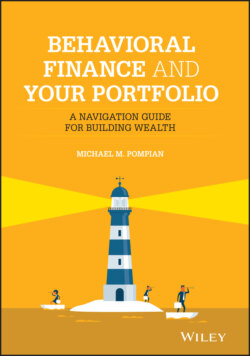Читать книгу Behavioral Finance and Your Portfolio - Michael M. Pompian - Страница 31
Why Understanding and Identifying Behavioral Biases Is Crucial
ОглавлениеBy understanding the effects that behavioral biases have on the investment process, investors may be able to significantly improve their economic outcomes and attain stated financial objectives. As noted in Chapter 1, during my 30+ year career advising clients, I have found that recognizing and managing the most frequently occurring behavioral biases is crucial to obtaining financial success. For many years I have had my “Top 3” most common behavioral biases—Loss Aversion, Confirmation and Recency biases. Coincidentally, a recent study by Charles Schwab confirms my Top 3, albeit in a slightly different order as can be seen in Figure 2.1 which illustrates how often financial advisors see each bias in the clients they serve. If you are short on time, and you want to only review the most common biases, skip ahead to the chapters containing Loss Aversion, Confirmation, and Recency biases.
Figure 2.1 Most Significant Behavioral Biases Affecting Client Investment Decisions 2019
Source: Charles Schwab
In my experience, simply identifying a behavioral bias at the right time can save investors from potential financial disaster. During my 30+, spanning numerous economic meltdowns, including but not limited to 1987 (my first year in the business), 1998, 2001, 2008–2009, 2018, and 2020, I've talked many of my clients “down from the ledge” and out of selling their risky assets at the wrong time due to irrational panic behavior. In fact, many of my long-time clients are now used to volatility and do not panic. They look at market drops as buying opportunities. This behavior-modifying advice has helped investors to reach their financial goals. In other cases, I was able to identify a behavioral bias or a group of biases and decided to adapt to the biased behavior so that overall financial decisions improved and the most appropriate portfolios were built—that is, one the investors could stick to over time. It is crucial for you to understand how you make decision to build the best portfolio for you. For example, some investors have a gambling instinct, or want to take risks with some of their capital. My advice in many of these cases is to carve out a small percentage of the portfolio for risky bets, leaving the vast majority of wealth in a prudent, well-organized portfolio. In short, knowledge of the biases reviewed in this book and the modification of or adaption to irrational behavior may lead to superior results.
